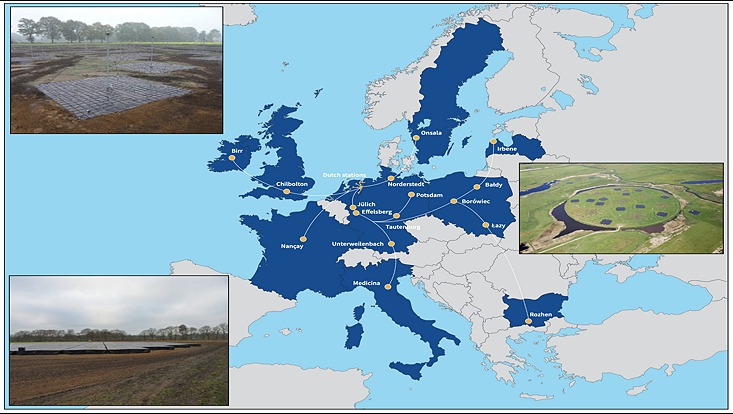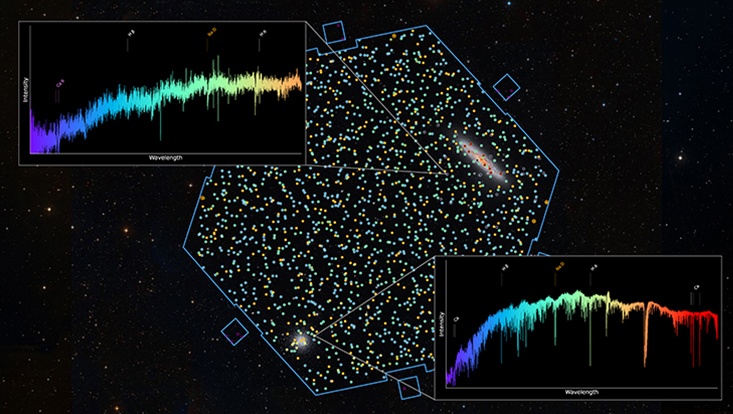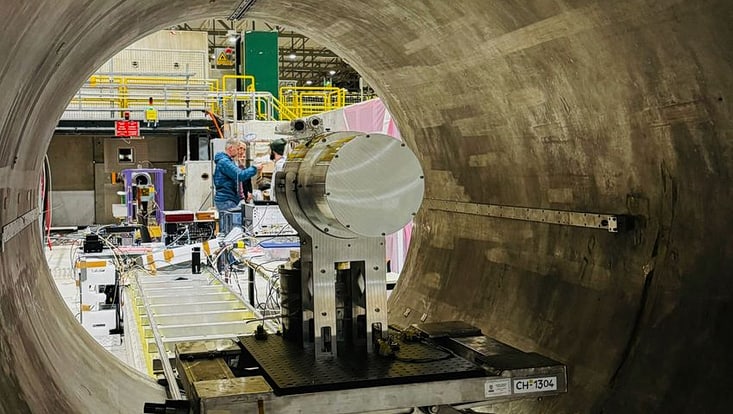Independent organisation established for LOFAR radio telescopeEuropean Commission decides to launch distributed research infrastructure for astronomical research
22 January 2024

Photo: ASTRON and D Engels/UHH
The Low Frequency Array (LOFAR) is the world's largest radio telescope for observing radio short waves and ultra-short waves. LOFAR is now being transformed into an independent legal form: a consortium for a European research infrastructure (European Research Infrastructure Consortium, ERIC). LOFAR ERIC was officially founded today (22 January 2024). The world-leading LOFAR Distributed Research Infrastructure has already revolutionised low-frequency radio astronomy research, resulting in an avalanche of scientific publications in the past decade. LOFAR ERIC is now a single legal entity across the European Union.
The University of Hamburg operates a LOFAR antenna field station together with the University of Bielefeld and has been actively involved in setting up the ERIC. The LOFAR radio telescope went into operation ten years ago. Today it is a pan-European project with 52 antenna stations in eight European countries. In Hamburg the astrophysicist Professor Dr Marcus Brüggen has been researching the origin of cosmic magnetic fields, which is also a research question of the Quantum Universe Cluster of Excellence.
Germany is one of the founding members
Six EU countries applied to the European Commission to set up the LOFAR ERIC and are its founding members: Bulgaria, Germany, Ireland, Italy, the Netherlands and Poland. The new research organisation cooperates with institutes in France, Latvia, Sweden and the United Kingdom. The first meeting of the board of the new research organisation, which is based in Dwingeloo at the Netherlands Institute for Radio Astronomy (NWO-I/ASTRON), took place today.
The LOFAR ERIC will implement a substantial upgrade across the distributed infrastructure, and serve the astronomy community with a cutting-edge suite of observing and data processing capabilities, rooted in its vast field of view on sky, unprecedented sensitivity and image resolution, and novel capabilities to observe in multiple directions all at once. Further development paths for the longer term are under study.
Half a decade of preparatory work for the European research organisation
"The fact that the LOFAR ERIC is a window to the Universe is of great importance not only for science, but also for European research policy," says Professor Dr Marcus Brüggen from the University of Hamburg, who was involved in setting up the new research organisation. "At Hamburg Observatory, we have developed the techniques that allow us to map the sky at the very lowest radio frequencies, also with the help of artificial intelligence."
Dr René Vermeulen from the Netherlands Institute for Radio Astronomy is the founding director of LOFAR ERIC. "The establishment of LOFAR ERIC consolidates Europe's global leadership in an important field of research," says the astrophysicist. "With its unrivalled distributed research infrastructure and strong pan-European partnership, LOFAR ERIC will join the European Research Area as a center of excellence at the forefront of astronomical science and technology with the potential to contribute to broader complex challenges."
Insights into the early universe and space weather
The LOFAR ERIC, set up with a long-term perspective, will provide transparent access to a wide range of science research services for the European and global community, fostering collaborations, and empowering researchers to pursue large-scale innovative projects across scientific domains, including the properties of the distant young universe, the formation and evolution of galaxies, the physics of pulsars and transient radio phenomena, the nature of ultra-high energy cosmic particles, the conditions in the interstellar medium, and the structure of cosmic magnetic fields. Furthermore, LOFAR ERIC contributes unique scientific insights into diverse topics with societal relevance, such as lightning, ionospheric disturbances, and Space Weather. LOFAR ERIC will facilitate access through its user-friendly publicly open archive for multiple use of its extensive science data products.
Further information
The UHH press release [in German]
LOFAR ERIC website
"LOFAR - a new window into the radio universe" [in German] (website of the Federal Ministry of Education and Research)
"New sky map provides a view of 4.4 million galaxies" [in German] (press release from 25 February 2022)
About LOFAR
LOFAR is the world’s largest and most sensitive radio telescope operating at low radio frequencies, between 10 and 240 MHz. It is a distributed research infrastructure that consists of multiple antenna stations, geographically distributed across Europe, all driven in software and with powerful computing and massive data storage at several distributed data centres. Jointly operated, this forms a unified, highly agile and capable observing and data processing system. With a sensitivity more than a hundred times better than any previous telescope at these frequencies, unparalleled image resolution across a large field of view, and capabilities to observe simultaneously in multiple directions, LOFAR is by far the most powerful low frequency telescope on the planet, and is revolutionising our view of the low-frequency radio universe. LOFAR was originally developed by NWO-I/ASTRON, the Netherlands Institute for Radio Astronomy, which now hosts LOFAR ERIC and furnishes most of the LOFAR ERIC operational services. LOFAR ERIC is jointly funded by its members and partners, that are collectively implementing a major upgrade (LOFAR2.0) for substantially improved and extended scientific research capabilities.
About LOFAR ERIC
LOFAR ERIC (LOw-Frequency ARray European Research Infrastructure Consortium) is securing the future of low-frequency radio astronomy by exploiting the LOFAR Distributed Research Infrastructure as a world-leading observatory for large-scale astronomical research. LOFAR ERIC consolidates Europe's global leadership in the field. It was set up by the European Commission on 20 December 2023. LOFAR ERIC's founding members are Bulgaria, Germany, Ireland, Italy, the Netherlands, and Poland. Institutes in France, Latvia, Sweden, and the United Kingdom also collaborate in LOFAR ERIC.


